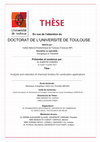Papers by Quentin Cazeres

La combustion de carburants fossiles est utilisée depuis des décennies pour nombre d'applicat... more La combustion de carburants fossiles est utilisée depuis des décennies pour nombre d'applications, de la génération d'électricité au fonctionnement des moteurs d'avions, mais c'est également une des raisons principales du dérèglement climatique. De nouveaux carburants, durables et moins polluants, doivent être étudiés afin de diminuer l'impact humain sur notre planète. La combustion est un procédé complexe alliant mécanique des fluides, thermodynamique et chimie avec des centaines d'espèces impliquées dans celle-ci. Afin de pouvoir utiliser les outils de la simulation numérique pour représenter des phénomènes de plus en plus complexes, des cas canoniques jusqu'à des Simulations aux Grandes Échelles (SGE), l'analyse des chemins chimiques prépondérants et la réduction des mécanismes réactifs est nécessaire. La Chimie Analytiquement Réduite (CAR) est une méthode pour réduire la taille et la complexité des mécanismes chimiques dans laquelle seules les esp...

Combustion of fossil fuels has been used for decades for all kinds of purposes, from generating e... more Combustion of fossil fuels has been used for decades for all kinds of purposes, from generating electricity to make air planes fly but they are also the main source of pollution leading to climate change. New sustainable, less polluting fuels must be studied in order to diminish as much as possible the human impact on the planet. Combustion is a very complex process combining fluid dynamics, thermodynamics and chemistry with hundreds of species involved. In order to be able to use all the tools the numerical simulation has to offer with increasing complexity, from canonical cases to 3D Large Eddy Simulations (LES) with two-phase flows, analysing the relevant chemical pathways and reducing the reaction mechanisms describing this chemistry is necessary. Analytically Reduced Chemistry (ARC) is a way of reducing the size and the complexity of chemical mechanisms where only the species and reactions relevant to given conditions are kept while keeping a physically coherent mechanism. ARC ...

Proceedings of the 22nd Australasian Fluid Mechanics Conference AFMC2020, 2020
Dilution of flames with hot combustion products can be used to reduce harmful emissions. However,... more Dilution of flames with hot combustion products can be used to reduce harmful emissions. However, diluted flames can combust as auto-ignitive, premixed or non-premixed flames, and are therefore challenging to model. The interaction of diluted flames with walls can impact exhaust emissions, and these effects are not well explored in the literature. Direct Numerical Simulation (DNS) can provide more insights into this phenomenon and aid the development of more accurate models. However to achieve this, inlet boundary conditions must ensure that imposed temperature and velocity profiles take into account the presence of walls. This paper will present a methodology to establish the inflow boundary conditions for a flame in a duct which are representative of coupled velocity and thermal boundary layers. The performance of this methodology will be assessed in a DNS of a diluted flame.

Combustion and Flame, 2021
Abstract Flames diluted by combustion products can reduce emissions such as Carbon Monoxide (CO) ... more Abstract Flames diluted by combustion products can reduce emissions such as Carbon Monoxide (CO) and Nitrogen Oxides (NO x ) in industrial applications. In gas turbines, these flames are confined in a combustor and can interact with relatively cold walls. This interaction can quench the flame, producing incomplete combustion products. In this study, Flame-Wall Interaction (FWI) for methane/air flames diluted by hot combustion products is investigated using direct numerical simulation. A three-Dimensional (3D) turbulent V-flame in a channel with isothermal hot and cold walls is simulated. It is shown that a main reaction zone in the central region between two walls supported by periodic bulk ignition events changes the position of volumetric reaction zones where CO is formed. The cold wall leads to a longer flame, thereby having disproportionately large contribution to the exhaust CO. Near-wall turbulence-flame interaction creates wrinkled and streaky flame surfaces, and localises the near-wall CO distribution. High mean CO mass fraction develops in the free-stream while a high magnitude of the peak RMS CO mass fraction is present closer to the wall. It is also shown that one-dimensional flame solutions can reasonably describe the changes of CO mass fraction as a function of temperature in the free-stream region and some parts of the near-wall region but not close to the wall. Turbulent mixing and diffusion effects contribute to this deviation. The results highlight the complexities involved in CO modelling for diluted flames and set a benchmark for future work.

Acta Astronautica, 2021
Abstract Methane–oxygen burning is considered for many future rocket engines for practicality and... more Abstract Methane–oxygen burning is considered for many future rocket engines for practicality and cost reasons. As this combustion is slower than hydrogen–oxygen, flame ignition and stability may be more difficult to obtain. To address these questions, numerical simulation with realistic chemistry is appropriate. However the high pressure and turbulence intensity encountered in rocket engines enhance drastically the stiffness of methane oxy-combustion. In this work, Analytically Reduced Chemistry (ARC) is proposed for accurate chemistry description at a reasonable computational cost. An ARC scheme is specifically derived for typical rocket engine conditions. It is validated by comparison with its parent skeletal mechanism on a series of laminar flames. Then the numerical stiffness of chemistry is overcome with an original approach for time integration, allowing to run simulations close to the acoustic time step whatever the chemical stiffness. It is demonstrated on laminar cases that the flame structure is well preserved, and that numerical stability is ensured while decreasing significantly the computational cost. The performance of ARC with the fast time integration method is finally demonstrated in a 3D Large-Eddy Simulation of a lab-scale Liquid Rocket Engine combustion chamber, where a detailed flame analysis is conducted.

Fuel, 2021
Abstract A new software called ARCANE has been developed to address the broad need for compact, c... more Abstract A new software called ARCANE has been developed to address the broad need for compact, computationally efficient chemical models for reactive flow simulations. Based on a new, fully automatic and optimised multi-step reduction methodology, ARCANE’s purpose is to provide a convenient and more accessible framework for the analysis and reduction of chemical kinetic mechanisms in the general context of combustion chemistry. The capabilities and performance of the methodology are demonstrated through 3 case studies. First, a classical methane/air system with and without nitrogen/oxygen chemistry is studied as a benchmark. The framework is then applied to a kerosene/air mechanism with a multi-component fuel formulation, showing the ability of the fully automatic method to handle complex chemistry. Finally, the generality of the approach is confirmed by developing reduced chemical models for a hydrocarbon steam cracking process.
Proceedings of the Combustion Institute, 2020
A computational study of one dimensional multicomponent laminar Jet-A/air spray flames is present... more A computational study of one dimensional multicomponent laminar Jet-A/air spray flames is presented. The objective is to understand the effect of various spray parameters (diameter, droplet velocity, liquid loading) on the spray flame structure and propagation. Simulation of the Eulerian gas phase is coupled with a Lagrangian tracking of the dispersed liquid phase. Jet-A surrogate of n-dodecane, methyl-cyclohexane and xylene is considered. A discrete multicomponent model for spray vapourisation is used along with an analytically reduced chemistry for computing the gas phase reactions.










Uploads
Papers by Quentin Cazeres